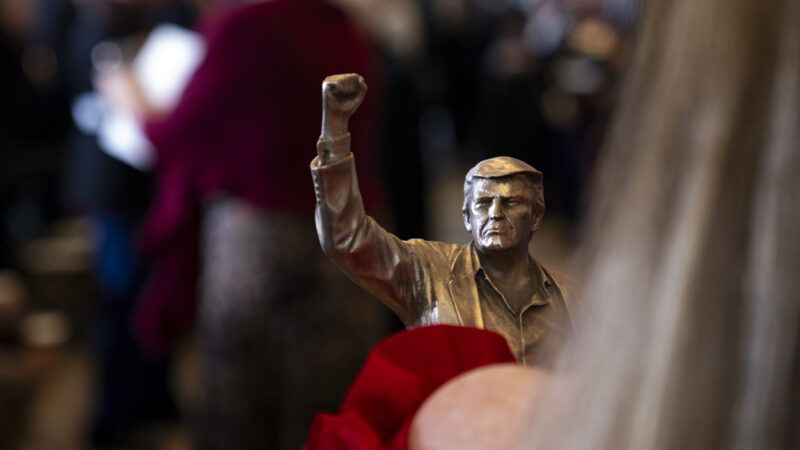Trump's Empty and Expensive Plan To Build 250 Statues of 'American Heroes'
The president's planned National Garden of American Heroes might be a nice idea, but it would be extremely costly—and unnecessary.

President Donald Trump has issued a flurry of executive orders since taking office three weeks ago, looking to reshape everything from global trade to women's collegiate sports. One order Trump signed would prioritize the construction of 250 statues of historical figures and a garden in which to put them.
While this plan is less controversial than many of Trump's other orders, it still represents an unnecessary and costly project.
"As we approach the [250th] anniversary…of our country's founding, I have signed an executive order to resume the process of creating a new national park full of statues of the greatest Americans who ever lived," Trump said last week at the National Prayer Breakfast.
Trump's order, issued January 29, reinstated an order from his first term, titled "Building and Rebuilding Monuments to American Heroes." It called for the creation of "a statuary park named the National Garden of American Heroes," with statues of "historically significant Americans…who have contributed positively to America throughout our history."
"Because the past is always at risk of being forgotten, monuments will always be needed to honor those who came before," proclaimed the original order, signed in July 2020. "These statues are silent teachers in solid form of stone and metal. They preserve the memory of our American story and stir in us a spirit of responsibility for the chapters yet unwritten."
"The National Garden will be built to reflect the awesome splendor of our country's timeless exceptionalism," Trump added in a second order, issued just two days before he left office in January 2021. "On its grounds, the devastation and discord of the moment will be overcome with abiding love of country and lasting patriotism. This is the American way."
The original order included 31 names of figures whose statues should be featured, while the second order brought the total to 244; to get the total to 250, the order Trump issued last month said a staffer would "recommend to the President additional historically significant Americans for inclusion in the National Garden of American Heroes." (Leaning into the theme of 250, the whole project is set to be concluded by July 4, 2026—the 250th anniversary of America's founding.)
Given that the original order was issued at a time of civil unrest, as protesters tore down monuments and Trump threatened offenders with up to 10 years in federal prison, it was comforting that all the names on Trump's first list were fairly innocuous—figures like George Washington, Martin Luther King Jr., and Orville and Wilbur Wright.
And while the second list was similarly uncontroversial, it did have a few odd and even downright peculiar inclusions. Along with beloved historical figures, the list also called for statues of several actors from classic films, like Lauren Bacall and Humphrey Bogart; Todd Beamer, a passenger on American Airlines Flight 93 on 9/11; Christa McAuliffe, the teacher who died on the Space Shuttle Challenger; and Alex Trebek, the late and beloved (but famously Canadian) host of Jeopardy!
Granted, it's understandable to want certain people from American history to get their due: Some, like Sojourner Truth and Medgar Evers, are belated but welcome inclusions. Others, like Andrew Jackson and William McKinley, are former presidents Trump seems to revere but who tend to rate poorly with the general public. And what Reason reader wouldn't enjoy seeing a statue of Milton Friedman sharing space with other historical greats?
But creating a garden with 250 statues of historical figures—many of whom already have numerous statues, placards, and buildings named in their honor—all in 18 months, is an expensive empty gesture.
"Building a national park with hundreds of statues is not a small undertaking," wrote Bloomberg's Kriston Capps. "The 4-acre Martin Luther King Jr. Memorial, which opened in Washington, DC, in 2011, cost about $120 million" and "took four years to design, approve and build."
"A more modestly scaled statue of evangelist Billy Graham, which was added to the National Statuary Hall at the US Capitol in May, cost about $650,000, suggesting that the price tag for a complete National Garden of American Heroes could easily rise to tens or hundreds of millions of dollars," Capps added. (Graham is on Trump's list for inclusion in the National Garden of American Heroes, and his original order from July 2020 included the possibility to "accept the donation or loan of statues," so perhaps that one could simply be transferred. One down, 249 to go!)
Rather, if Trump wants these figures to be lionized in physical form, then he should take a page from the Martin Luther King Jr. Memorial, which raised money from private donors for its construction. If people want to contribute to the cause of dozens of statues commemorating a grab bag of historical figures, they're free to do so. There's no need to drag the American taxpayer into it.
"Given that bronze and stone replicas of fallible human beings seem incapable of serving any unifying purpose for people forced to pay taxes to erect them, it's time to get government out of the monument business," J.D. Tuccille wrote in Reason in 2020. "From now on, let private groups celebrate their fandom on their own dime, and on their own property."


Show Comments (91)